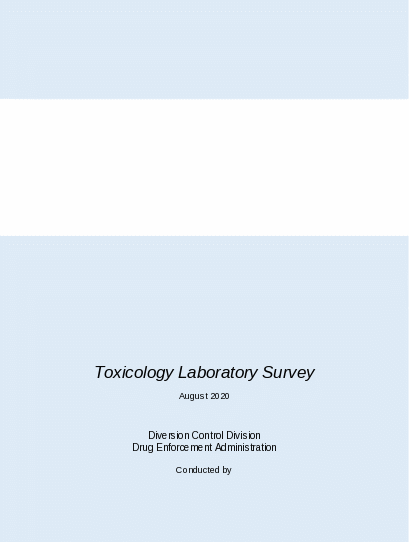Collection of Laboratory Analysis Data on Drug Samples Tested by Non-Federal (State and Local Government) Crime Laboratories (monthly)
The National Forensic Laboratory Information System Collection of Analysis Data
2020_TOX Survey_04-29-20
Collection of Laboratory Analysis Data on Drug Samples Tested by Non-Federal (State and Local Government) Crime Laboratories (monthly)
OMB: 1117-0034
 OMB
Clearance # 1117-0034
OMB
Clearance # 1117-0034
OMB Clearance Expiration Date 12/31/2022

National Forensic Laboratory Information System Survey
The purpose of the National Forensic Laboratory Information System (NFLIS) survey is to gather key information from each toxicology laboratory in terms of organizational context, caseload, toxicology requesting practices, and capability of collecting and reporting a set of core data items (e.g., toxicology results). This information will be used to update information gathered during the 2017 Toxicology Laboratory Survey and to help the DEA to further drug surveillance data system. Aggregated survey results will be posted on the NFLIS website: https://www.nflis.deadiversion.usdoj.gov
As the primary agency for enforcing the controlled substances laws and regulations of the United States, the Drug Enforcement Administration (DEA) strives to develop information sources on the prevalence and distribution of emerging and commonly available and used drugs. Since its inception in 1997, NFLIS has provided a systematic approach for collecting data on solid-dosage drug analyses conducted by federal, state, and local forensic laboratories across the country. NFLIS has provided the DEA with an efficient, reliable, and comprehensive data resource for monitoring drug schedule actions; tracking drug trends; and identifying new substances of use, misuse, and abuse. NFLIS also provides the toxicology community with midyear, annual, and special reports on drug seizure data submitted by participating laboratories.
The DEA has enhanced its efforts to combat diversion and identify new and emerging substances of misuse and abuse by expanding NFLIS to include public and private toxicology laboratory data regarding postmortem and antemortem toxicology testing. This expansion to toxicology laboratories supplement current drug seizure data from forensic drug laboratories.

Instructions for Completing the 2020 Toxicology Laboratory Survey
Refer to the jurisdictions your toxicology laboratory serves when answering questions. If your laboratory’s jurisdiction includes more than one county, respond for all counties.
Answer all questions based on calendar year 2019 data.
Please use a BLACK or DARK BLUE ink pen to mark your answers.
Be sure to read all the answer choices before marking your answer.
Some questions ask you to select only one answer option while others ask you to select all that apply. Look for instructions in italics after the question telling you which response style is appropriate for that item.
Sometimes the instructions will say to skip one or more questions. Look for notes in bold telling you whether you should go to a particular question based on your response. If there is no note, go to the next question.
Answer all questions by filling in the circle or square next to your answer choice, like this:



Example
Did you read this question? Select only one option.
Yes Go to Question 3
No
Return the completed survey by mail using the postage-paid envelope provided
OR
use the online survey option at
URL: https://deanflissurveys.rti.org
Username: [caseid]
Password: [password]
If you need assistance to answer any question, please e-mail RTI staff at [email protected] or call RTI staff at 1-866-784-7723.
We appreciate your voluntary responses. Your participation provides the information the DEA needs to continue critical national surveillance systems to combat our nation’s drug problem.
Thank you for your time!

 SECTION
1: TOXICOLOGY LABORATORY IDENTIFICATION
SECTION
1: TOXICOLOGY LABORATORY IDENTIFICATION
The purpose of this section is to ensure that we have the correct contact information for your toxicology laboratory and to gather a general profile of your laboratory.
We have the official name of your laboratory as [LABNAME]. Is this correct? Select only one option.
A. Yes, this is correct.
B. No, this is not correct. Please provide the corrected name below.
Please review the mailing address and contact information for this laboratory as shown below. Is this correct? Select only one option.
A. Yes, this is correct.
B. No, this is not correct. Please fill in changes below.
|
Current Information on File |
Enter Needed Changes Below |
Address Line 1: |
[Address1] |
|
Address Line 2: |
[Address2] |
|
City: |
[City] |
|
State: |
[State] |
|
ZIP Code: |
[ZIP] |
|
Telephone Number: |
[phone] |
|
Toxicology Extension: |
[ext] |
|
We have the director/chief position as shown below. Is this correct? Select only one option.
|
Current Information on File |
Enter Needed Changes Below |
Job Title: |
[AgencyHead_Title] |
|
Salutation: (e.g., Dr., Mr., Ms.) |
[AgendyHead_Sal] |
|
First Name: |
[AgencyHead_FN] |
|
Last Name: |
[AgencyHead_LN] |
|
Telephone Number: |
[AgencyHead_Phone] |
|
Extension: |
[AgencyHead_Ext] |
|
Email Address: |
[AgencyHead_Email] |
|
 Section
1 continues here.
Section
1 continues here.
Select the best description of your laboratory. Select only one option.
A1. Publicly funded Federal laboratory
B1. Publicly funded State laboratory

C1. Publicly funded district/regional laboratory (serves a specified area in the State that could include multiple counties, municipalities, or locales) Answer C1a below
C1a. What geographic area(s) does your laboratory serve (e.g., District 9 - Florida, Staten Island Borough, New York City)?
D1. Publicly funded county laboratory Answer D1a below
D1a. What county(ies) does your laboratory serve?
E1. Publicly funded city/municipal laboratory Answer E1a below
E1a. What city(ies) or municipality(ies) does your laboratory serve?
F1. Privately owned and operated laboratory Answer F1a and F1b below
F1a. Where are the majority of your clients located? Select only one option.
A. Nationwide
B. Regional (multiple nearby states)
C. Statewide (throughout my state)
D. Localized (in my community or surrounding communities)
F1b. What type of client(s) does your laboratory mostly serve? Select only one option.
A. University-affiliated clients
B. Hospital-affiliated clients
C. Neither of these
Are alcohol testing services the only type of toxicology service provided in-house by your laboratory? Select only one option.
The NFLIS Toxicology Laboratory Survey only collects information on drug-related cases and not alcohol-only cases. Laboratories with only alcohol testing services are excluded.
Does your laboratory provide only toxicology services or more than toxicology services? Select only one option.
A. Only toxicology services
B. More than toxicology services (e.g., other forensics)
Which of the following types of toxicology testing does your laboratory conduct? Select all that apply.
A. Postmortem toxicology testing
B. Clinical drug testing (e.g., substance abuse treatment, methadone maintenance, pain management, primary care, mental health)
C. Human performance testing (e.g., DUID, DFSA, major crime, vehicular manslaughter)
D. Workplace drug testing
E. Criminal justice supervision testing (e.g., probation, parole)
F. Performance enhancing drug testing (e.g., sports testing)
Does your laboratory use a reference toxicology laboratory? Select only one option.
Reference toxicology laboratory: An off-site toxicology laboratory that a toxicology laboratory uses for additional testing. For example, a toxicology laboratory may send specimens to a reference laboratory for synthetic cannabinoid or synthetic cathinone testing.
A. Yes
B. No Go to Question 10
Section 1 continues here.
Enter the name and location of each reference toxicology laboratory used by your laboratory.
Laboratory Name
Laboratory City
Laboratory State
1
2
3
4

Does your laboratory serve as a reference toxicology laboratory for other laboratories? Select only one option.
A. Yes
B. No
Which of the following best describes your laboratory’s organizational structure? Select only one option.
A. Standalone facility with no organizational relationship to other laboratories Go to Question 14
B. Central laboratory in a network
C. Satellite laboratory in a network
Does your laboratory electronically share data within your laboratory network? Select only one option.
A. Yes
B. No

_ _ _

Section 1 continues here.
Is your laboratory accredited by any of the following organizations? Select all that apply.
A. ANSI National Accreditation Board (ANAB) (formerly American Society of Crime Laboratory Directors/Laboratory Accreditation Board (ASCLD/LAB))
B. American Board of Forensic Toxicology (ABFT)
C. National Laboratory Certification Program (NLCP)
D. College of American Pathologists (CAP)
E. Clinical Laboratory Improvement Amendments (CLIA)
F. American Association for Laboratory Accreditation (A2LA)
G. State accredited
H. Other Federal agency accredited
I. None of the above

 Section
2. Caseload and Testing Practices
Section
2. Caseload and Testing Practices
This section asks about your toxicology cases submitted in calendar year 2019, types of inquiries, turnaround time, and selected drug and drug class toxicology requests for analysis.
Toxicology cases: Cases submitted to the toxicology laboratory for analysis of drugs (e.g., drugs of abuse, prescription drugs) in biological matrices. This excludes any cases where only alcohol testing was performed and any specimens analyzed for research purposes.
Enter the total number of toxicology cases submitted to your laboratory during calendar year 2019, excluding alcohol only cases.
_ _ _, _ _ _, _ _ _ cases

Check this box if the total number of submitted cases is an estimate.
□
Using the Question 15 total number of submitted toxicology cases submitted for calendar year 2019, enter the number of cases tested for each type of toxicological testing performed.
If data are not available, please provide an estimate and mark the box to the right. If your laboratory does not perform toxicological testing for a specific area, enter 0 for the number of cases.
Toxicological Testing Performed |
Total Number of Cases Tested in 2019 |
Estimate |
A. Postmortem testing |
_ _ _, _ _ _ |
□ |
B. Clinical drug testing (e.g., substance abuse treatment, methadone maintenance, pain management, primary care, mental health) |
_ _ _, _ _ _ |
□ |
C. Human performance testing (e.g., DUID, DFSA, major crime, vehicular manslaughter) |
_ _ _, _ _ _ |
□ |
D. Workplace drug testing |
_ _ _, _ _ _ |
□ |
E. Probation/parole testing |
_ _ _, _ _ _ |
□ |
F. Performance-enhancing drug testing (e.g., sports testing) |
_ _ _, _ _ _ |
□ |
Sum of cases entered in rows A – F |
_ _ _, _ _ _, _ _ _ |
□ |
|
This number should equal the number entered in Question 15. |
|
Enter the total number of toxicology samples submitted to your laboratory during calendar year 2019, excluding alcohol only items.
Toxicology sample: A biological sample or a portion of a biological sample used for toxicological testing. The number of samples is likely equal to or greater than the number of submitted cases.
-
_ _ _, _ _ _, _ _ _ samples

Check this box if the total number of submitted samples is an estimate.
□
Enter the total number of toxicology tests conducted by your laboratory on samples submitted to your laboratory during calendar year 2019, excluding alcohol only tests. Include all tests conducted on each sample.
Toxicology tests: Different analytical methods conducted on a biological matrix.
-
_ _ _, _ _ _, _ _ _ tests

Check this box if the total number of referred tests is an estimate.
□
In general, what was the average turnaround time, in days, for completion of a toxicology case submitted to your laboratory during calendar year 2019, excluding alcohol only testing?
_ _ _ days

Check this box if the average turnaround time entered is an estimate.
□
What type(s) of testing does your toxicology laboratory use for presumptive screening? Select all that apply.
A. Immunoassay
B. GC-MS
C. GC-MS/MS
D.GC-FID, GC-NPD, or GC-ECD
E. LC-MS
F. LC-MS/MS
H. Other
 Section
2 continues here.
Section
2 continues here.
What type(s) of testing does your toxicology laboratory use for confirmation? Select all that apply.
A. GC-MS
B. GC-MS/MS
C. LC-MS
D. LC-MS/MS
E. High Resolution MS
F. We send confirmations to a reference toxicology laboratory
G. Other
In the case of novel psychoactive substances, what is the normal course of action for conducting toxicology analysis? Select all that apply.
A. We submit these cases to a reference laboratory
B. We do not conduct an analysis of these substances
C. We conduct some novel psychoactive substance testing in-house
D. We screen for some novel psychoactive substances in-house and then send to a reference laboratory for confirmation
E. We help the submitting agency find a reference laboratory to send the sample to for testing
F. None of the above
 Section
2 continues here.
Section
2 continues here.
For the 2019 calendar year, indicate the qualitative analysis frequency and the quantitative analysis frequency of the following drugs/drug classes that are typical for toxicology analysis. If your laboratory requested toxicology analysis from a reference toxicology laboratory during calendar year 2019 for a particular drug or drug class, check the box on the right.
Drug/Drug Class |
Qualitative Analysis Frequency |
Quantitative Analysis Frequency |
Reference Laboratory
Instruction: Please check if your laboratory requested toxicology analysis from a reference laboratory for this drug/drug class during calendar year 2019. |
||||||||||
Routinely |
testing for drug is part of a standard panel |
Routinely |
positive results are routinely quantified |
||||||||||
Sometimes |
testing is done on an individual case basis |
Sometimes |
positive results are quantified on an individual case basis |
||||||||||
Rarely |
testing is rarely done for the particular drug or drug class |
Rarely |
positive results are rarely quantified for the particular drug or drug class |
||||||||||
1. Amphetamines |
○ 1 Routinely |
○ 2 Sometimes |
○ 3 Rarely |
○ 1 Routinely |
○ 2 Sometimes |
○ 3 Rarely |
|
||||||
2. Anticonvulsants |
○ 1 Routinely |
○ 2 Sometimes |
○ 3 Rarely |
○ 1 Routinely |
○ 2 Sometimes |
○ 3 Rarely |
|
||||||
3. Antidepressants |
○ 1 Routinely |
○ 2 Sometimes |
○ 3 Rarely |
○ 1 Routinely |
○ 2 Sometimes |
○ 3 Rarely |
|
||||||
4. Antipsychotics |
○ 1 Routinely |
○ 2 Sometimes |
○ 3 Rarely |
○ 1 Routinely |
○ 2 Sometimes |
○ 3 Rarely |
|
||||||
5. Barbiturates |
○ 1 Routinely |
○ 2 Sometimes |
○ 3 Rarely |
○ 1 Routinely |
○ 2 Sometimes |
○ 3 Rarely |
|
||||||
6. Benzodiazepines |
○ 1 Routinely |
○ 2 Sometimes |
○ 3 Rarely |
○ 1 Routinely |
○ 2 Sometimes |
○ 3 Rarely |
|
||||||
7. Buprenorphine |
○ 1 Routinely |
○ 2 Sometimes |
○ 3 Rarely |
○ 1 Routinely |
○ 2 Sometimes |
○ 3 Rarely |
|
||||||
8. Carisoprodol |
○ 1 Routinely |
○ 2 Sometimes |
○ 3 Rarely |
○ 1 Routinely |
○ 2 Sometimes |
○ 3 Rarely |
|
||||||
9. Cocaine |
○ 1 Routinely |
○ 2 Sometimes |
○ 3 Rarely |
○ 1 Routinely |
○ 2 Sometimes |
○ 3 Rarely |
|
||||||
10. Ethanol |
○ 1 Routinely |
○ 2 Sometimes |
○ 3 Rarely |
○ 1 Routinely |
○ 2 Sometimes |
○ 3 Rarely |
|
||||||
11. Fentanyl |
○ 1 Routinely |
○ 2 Sometimes |
○ 3 Rarely |
○ 1 Routinely |
○ 2 Sometimes |
○ 3 Rarely |
|
||||||
12. Fentanyl-related compounds (e.g., acetyl fentanyl) |
○ 1 Routinely |
○ 2 Sometimes |
○ 3 Rarely |
○ 1 Routinely |
○ 2 Sometimes |
○ 3 Rarely |
|
||||||
13. Gabapentin |
○ 1 Routinely |
○ 2 Sometimes |
○ 3 Rarely |
○ 1 Routinely |
○ 2 Sometimes |
○ 3 Rarely |
|
||||||
14. Heroin |
○ 1 Routinely |
○ 2 Sometimes |
○ 3 Rarely |
○ 1 Routinely |
○ 2 Sometimes |
○ 3 Rarely |
|
||||||
15. Inhalants/volatiles |
○ 1 Routinely |
○ 2 Sometimes |
○ 3 Rarely |
○ 1 Routinely |
○ 2 Sometimes |
○ 3 Rarely |
|
||||||
16. Ketamine |
○ 1 Routinely |
○ 2 Sometimes |
○ 3 Rarely |
○ 1 Routinely |
○ 2 Sometimes |
○ 3 Rarely |
|
||||||
17. Marijuana/THC |
○ 1 Routinely |
○ 2 Sometimes |
○ 3 Rarely |
○ 1 Routinely |
○ 2 Sometimes |
○ 3 Rarely |
|
||||||
18. Muscle relaxants |
○ 1 Routinely |
○ 2 Sometimes |
○ 3 Rarely |
○ 1 Routinely |
○ 2 Sometimes |
○ 3 Rarely |
|
||||||
19. Opiates/opioids (other than heroin and fentanyl) |
○ 1 Routinely |
○ 2 Sometimes |
○ 3 Rarely |
○ 1 Routinely |
○ 2 Sometimes |
○ 3 Rarely |
|
||||||
20. Over-the-counter medications (e.g., guaifenesin, ibuprofen) |
○ 1 Routinely |
○ 2 Sometimes |
○ 3 Rarely |
○ 1 Routinely |
○ 2 Sometimes |
○ 3 Rarely |
|
||||||

Drug/Drug Class |
Qualitative Analysis Frequency |
Quantitative Analysis Frequency |
Reference Laboratory
Instruction: Please check if your laboratory requested toxicology analysis from a reference laboratory for this drug/drug class during calendar year 2019. |
||||||
Routinely |
testing for drug is part of a standard panel |
Routinely |
positive results are routinely quantified |
||||||
Sometimes |
testing is done on an individual case basis |
Sometimes |
positive results are quantified on an individual case basis |
||||||
Rarely |
testing is rarely done for the particular drug or drug class |
Rarely |
positive results are rarely quantified for the particular drug or drug class |
||||||
21. Phencyclidine (PCP) |
○ 1 Routinely |
○ 2 Sometimes |
○ 3 Rarely |
○ 1 Routinely |
○ 2 Sometimes |
○ 3 Rarely |
|
||
22. Phenethylamines (e.g., 2-CI, 25I-NBOMe) |
○ 1 Routinely |
○ 2 Sometimes |
○ 3 Rarely |
○ 1 Routinely |
○ 2 Sometimes |
○ 3 Rarely |
|
||
23. Piperazines (e.g., BZP, TFMPP) |
○ 1 Routinely |
○ 2 Sometimes |
○ 3 Rarely |
○ 1 Routinely |
○ 2 Sometimes |
○ 3 Rarely |
|
||
24. Synthetic cannabinoids |
○ 1 Routinely |
○ 2 Sometimes |
○ 3 Rarely |
○ 1 Routinely |
○ 2 Sometimes |
○ 3 Rarely |
|
||
25. Synthetic cathinones (e.g., bath salts) |
○ 1 Routinely |
○ 2 Sometimes |
○ 3 Rarely |
○ 1 Routinely |
○ 2 Sometimes |
○ 3 Rarely |
|
||
26. Z-drugs (e.g., zolpidem, zopiclone) |
○ 1 Routinely |
○ 2 Sometimes |
○ 3 Rarely |
○ 1 Routinely |
○ 2 Sometimes |
○ 3 Rarely |
|
||

 Section
3. Information Management System Overview
Section
3. Information Management System Overview
This section gathers information about your laboratory’s information management system and whether your laboratory captures the core data items NFLIS is interested in collecting.
How would you characterize your laboratory’s information management system? Select only one option.
A. Computerized, networked system
A computerized system that is connected to a network on which personnel can access the same information from different computers. Networked does not mean that instrumentation is networked to the case management system so that toxicology results are automatically imported.
B. Computerized, non-networked system
A computerized system that is not connected to a network on which personnel can access the same information from different computers.
C. Partially computerized system, some manual record-keeping
Some case data are stored in a computerized system, whereas other case data are stored as paper-based files.
D. Manual record-keeping system

All case data are stored as paper-based files and are not accessible by a computer.
D1. Are there any plans in the next 3 years to transition to a computerized information management system? Go to Question 27
A. Yes
B. No
C. Don’t know
E. Other (please specify)

Please provide the name of the information management system you are using. Select only one option.
A. Bar Coded Evidence Analysis Statistics and Tracking (BEAST)
B. CGM LABDAQ
C. Forensic Advantage
E. In-house laboratory information management system (e.g., Access database)
F. JusticeTrax
G. Labgen
H. LabHealth
I. Orchard Harvest
J. StarLIMS
K. VertiQ
L. Not applicable
M. Don’t know
N. Other (please specify)
Do you incorporate results for samples sent to a reference laboratory into your information management system? Select only one option.
A. Yes
B. No
C. We do not send samples to a reference laboratory
 Section
3 continues here.
Section
3 continues here.
Indicate whether your laboratory’s case records capture the following data elements and whether they are stored electronically.
Core Data Items Collected by the Toxicology Laboratory |
Data Item Is Available in Case Records |
Instruction: Skip these columns if your agency keeps manual records only.
Is the Data Item Stored in an Electronic Information Management System? |
||||
1. Requesting office type or agency (e.g., pain management, substance abuse treatment clinic, primary care, medical examiner/coroner office, law enforcement, courts) |
○ 1 Always |
○ 2 Sometimes |
○ 3 Never |
○ 1 Always |
○ 2 Sometimes |
○ 3 Never |
2. Case type (e.g., driving/postmortem/major crime) |
○ 1 Always |
○ 2 Sometimes |
○ 3 Never |
○ 1 Always |
○ 2 Sometimes |
○ 3 Never |
3. Requesting office location (e.g., city, county, ZIP Code) |
○ 1 Always |
○ 2 Sometimes |
○ 3 Never |
○ 1 Always |
○ 2 Sometimes |
○ 3 Never |
4. Case ID/Unique identifier |
○ 1 Always |
○ 2 Sometimes |
○ 3 Never |
○ 1 Always |
○ 2 Sometimes |
○ 3 Never |
5. Sex of individual |
○ 1 Always |
○ 2 Sometimes |
○ 3 Never |
○ 1 Always |
○ 2 Sometimes |
○ 3 Never |
6. Age of individual |
○ 1 Always |
○ 2 Sometimes |
○ 3 Never |
○ 1 Always |
○ 2 Sometimes |
○ 3 Never |
7. Drug(s) and metabolite(s) confirmed |
○ 1 Always |
○ 2 Sometimes |
○ 3 Never |
○ 1 Always |
○ 2 Sometimes |
○ 3 Never |
8. Concentration with units for confirmed results |
○ 1 Always |
○ 2 Sometimes |
○ 3 Never |
○ 1 Always |
○ 2 Sometimes |
○ 3 Never |
9. Sample matrix used for confirmed result |
○ 1 Always |
○ 2 Sometimes |
○ 3 Never |
○ 1 Always |
○ 2 Sometimes |
○ 3 Never |
10. Legitimately prescribed medications in patient profile |
○ 1 Always |
○ 2 Sometimes |
○ 3 Never |
○ 1 Always |
○ 2 Sometimes |
○ 3 Never |

 Section
4. Participation in a National Data Collection System
Section
4. Participation in a National Data Collection System
In this section, we ask about assistance needed to ease participation in the NFLIS data collection, potential barriers to participation, and benefits that this data collection provides to your laboratory. Please visit https://www.nflis.deadiversion.usdoj.gov/FAQ.aspx for more information on the NFLIS data collection program.
What types of assistance would ease your participation in NFLIS? Select all that apply.
A. Computer hardware
B. Computer software
C. Assistance with programming
D. Direct financial assistance to support data acquisition and reporting (e.g., funding for overtime labor)
E. Additional personnel
F. Don’t know
G. None of the above
Generally, what are the main potential barriers for your laboratory to participate in NFLIS data collection efforts? Select all that apply.
A. Lack of electronic records
B. Lack of resources for data conversion to other systems
C. Concerns about privacy or security
D. Concerns that participation will not benefit my laboratory
E. Client concerns
F. Legal concerns
G. Participation overlaps with other data collection efforts
H. Unavailable personnel to work on this data collection effort (not including software or other IT related personnel)
I. Unavailable personnel for software or other IT related needs for this data collection effort
J. Unwillingness to share data with Federal agencies
K. Political climate or restrictions
L. Resource limitations (e.g., financial)
M. None of the above
 Section
4 continues here.
Section
4 continues here.
What information from NFLIS is most beneficial to your laboratory? Select all that apply.
A. Drug frequency trends
B. New drug trends
C. Geographic drug trends
D. Practices of other laboratories
E. Our laboratory does not see a benefit from this data collection effort
F. Other benefits (please specify)
G. None of the above
What is the contact information of the person who is submitting this survey?
We may follow-up with you if there are questions about answers you have provided or for data quality purposes. We may also use your information for potential future contact related to NFLIS participation.
Job Title: |
|
Salutation: (e.g., Dr., Mr., Ms.) |
|
First Name: |
|
Last Name: |
|
Telephone Number: |
|
Extension: |
|
E-mail Address: |
|

Thank you!
We appreciate your time and responses. Your participation will help inform DEA’s efforts to continue this important national drug surveillance system.
Please return your completed survey in the postage-paid envelope provided.
If you no longer have the postage-paid envelope, please mail to:
RTI International – Research Operations Center
2020 NFLIS Toxicology Laboratory Survey
Attention: Data Capture (0215762.111.010.021)
5265 Capital Boulevard, One North Commerce Center
Raleigh, NC 27616-2925
| File Type | application/vnd.openxmlformats-officedocument.wordprocessingml.document |
| Author | Moore, Katherine |
| File Modified | 0000-00-00 |
| File Created | 2021-11-16 |
© 2025 OMB.report | Privacy Policy



 Section
1 continues here.
Section
1 continues here.